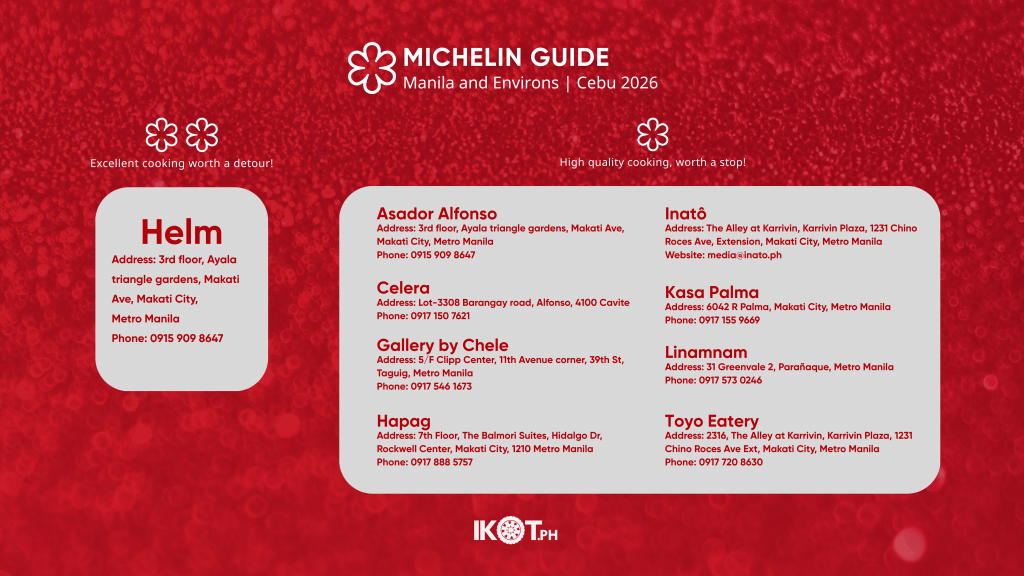When you wish upon a Michelin star…
There is something deeply moving about seeing the world recognize what we’ve always known — that the heart of Filipino cuisine lies not in extravagance, but in the warmth of a shared meal, the simplicity of home, and the stories carried by every bite. From kitchens that once fed families and friends to dining rooms that now dazzle the global stage, our chefs have proven that Filipino food is more than flavor — it is identity, memory, and love served from the soul of a nation.
When we first spotlighted Hapag, Toyo Eatery, Gallery by Chele, and Metiz back on March 15, 2025 (Read here), we called them the future of Filipino fine dining—trailblazers who were quietly rewriting what it means to serve lutong Pinoy on the world stage. Just seven months later, that vision has come to life.

The Philippines has officially earned its place among the world’s culinary greats. On October 30, the Michelin Guide Philippines unveiled its inaugural selection at a historic ceremony held at the Manila Marriott Hotel in Newport World Resorts, marking the country’s first-ever appearance in the globally revered red book. It was a night that didn’t just honor restaurants—it celebrated identity, artistry, and heart.
Eight Filipino restaurants now hold a Michelin star, joining the global ranks of excellence: Asador Alfonso, Celera, Gallery by Chele, Hapag, Inato, Kasa Palma, Linamnam, and Toyo Eatery. Each was recognized for high-quality cooking “worth a stop,” a testament to their mastery of flavor, story, and soul.

The most emotional highlight of the evening, however, came when Helm, by Chef Josh Boutwood, made history as the first Philippine restaurant to ever receive two Michelin stars—a powerful symbol of how far local talent has come and how high it can soar.


Meanwhile, our early favorites have lived up to their promise and more. Hapag continues to honor the Filipino spirit of communal dining with deep emotion and craft. Toyo Eatery redefines native flavors with elegance and intellect. Gallery by Chele remains a bridge between Filipino terroir and global technique. And Metiz, awarded the Michelin Selected distinction, stays true to its minimalist, ingredient-forward philosophy—proving that quiet innovation speaks volumes.
The Michelin Guide also unveiled the Bib Gourmand awardees, celebrating restaurants that offer exceptional three-course meals at reasonable prices. The 25 honorees—including Lampara, Sarsa, Manam at the Triangle, Abaseria Deli & Cafe, The Pig & Palm, and Your Local—show that great food in the Philippines is not just about prestige, but accessibility and heart.

If you’re wondering why we didn’t get a three-star Michelin, here’s some perspective: across the globe, there are only 157 three-star restaurants. Only 17 were added to this year’s list from last year’s 140. So for a country that just debuted in the Red Book, earning even a two-star Michelin distinction is already an extraordinary feat—a testament to the Philippines’ arrival on the global culinary map.
Beyond the stars and honors, this moment is a love letter to Filipino dining. It’s for the palengke vendors, farmers, home cooks, and chefs who have carried the flavors of our culture through generations. It’s proof that Filipino cuisine is not just ready for the world—it’s ready to lead it.
The Michelin stars that now shine over the Philippines do more than honor kitchens—they illuminate a nation’s story of resilience, creativity, and pride. And as the world finally tastes what we’ve always known—that Filipino food is world-class—the journey of our cuisine is just beginning.


